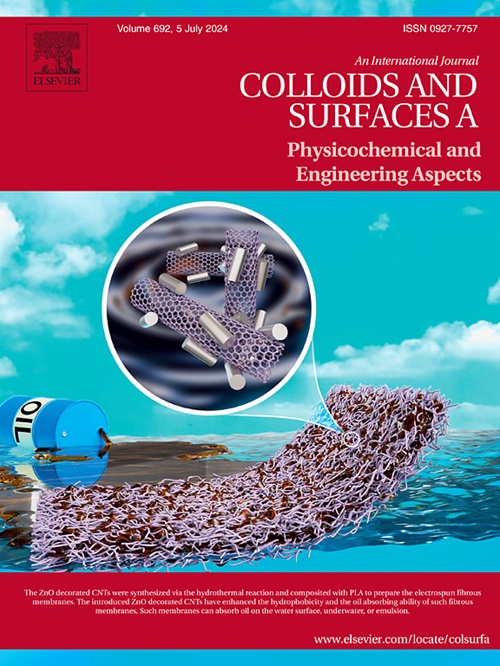The influence of amino and carboxyl groups on the corrosion inhibition performance of Azole inhibitors in chemical mechanical polishing processes
IF 4.9
2区 化学
Q2 CHEMISTRY, PHYSICAL
Colloids and Surfaces A: Physicochemical and Engineering Aspects
Pub Date : 2025-04-25
DOI:10.1016/j.colsurfa.2025.137048
引用次数: 0
Abstract
Amino and carboxyl groups are two of the most common and significant functional groups in corrosion inhibitors for chemical mechanical polishing (CMP) slurries. However, previous theoretical calculations often overlook the alterations in the metal surface and inhibitors in complex slurry environments, which can lead to inaccurate predictions of corrosion inhibition performance. This present investigation focuses on 3,5-diamino-1,2,4-triazole (DAT) and 3-amino-5-carboxylic acid-1,2,4-triazole (ACT), adopting an integrated approach that combines systematic experimental studies with theoretical calculations to compare the effects of these two functional groups on corrosion inhibition performance. Rigorous modeling was employed to address the dissociation of the carboxyl groups and the changes in copper surface composition. Density functional theory (DFT) calculations were utilized to elucidate the adsorption configurations and energies of the corrosion inhibitors on copper surfaces. The results indicate that the diatomic adsorption involving deprotonated carboxyl groups are the primary factor responsible for the superior corrosion inhibition performance of ACT compared to DAT. The theoretical calculations, which align with the experimental findings, underscore the importance of rigorous modeling and provide insights for future research.
氨基和羧基对化学机械抛光过程中唑类缓蚀剂缓蚀性能的影响
氨基和羧基是化学机械抛光(CMP)浆料缓蚀剂中最常见和最重要的两个官能团。然而,以往的理论计算往往忽略了复杂泥浆环境中金属表面和抑制剂的变化,这可能导致对缓蚀性能的预测不准确。本研究以3,5-二氨基-1,2,4-三唑(DAT)和3-氨基-5-羧酸-1,2,4-三唑(ACT)为研究对象,采用系统实验研究与理论计算相结合的方法,比较了这两种官能团对缓蚀性能的影响。采用严格的模型来处理羧基的解离和铜表面组成的变化。利用密度泛函理论(DFT)计算了缓蚀剂在铜表面的吸附构型和能。结果表明,与DAT相比,ACT的缓蚀性能优于DAT的主要原因是脱质子羧基的双原子吸附。理论计算与实验结果一致,强调了严格建模的重要性,并为未来的研究提供了见解。
本文章由计算机程序翻译,如有差异,请以英文原文为准。
求助全文
约1分钟内获得全文
求助全文
来源期刊
CiteScore
8.70
自引率
9.60%
发文量
2421
审稿时长
56 days
期刊介绍:
Colloids and Surfaces A: Physicochemical and Engineering Aspects is an international journal devoted to the science underlying applications of colloids and interfacial phenomena.
The journal aims at publishing high quality research papers featuring new materials or new insights into the role of colloid and interface science in (for example) food, energy, minerals processing, pharmaceuticals or the environment.

 求助内容:
求助内容: 应助结果提醒方式:
应助结果提醒方式:


